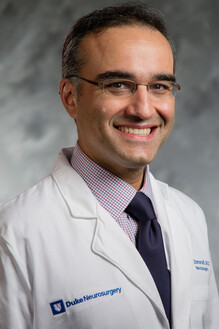Duke Team Safely Removes Rare Brain Abnormality
Life-Threatening Cavernoma Caused Two Strokes Before Operation

Chase Conklin, 34, smiles outside her home in South Mills, NC (photo by her wife Melissa Conklin)
In Fall 2021, Chase Conklin began experiencing blurry vision, fatigue, brain fog, and balance problems, but she ignored her symptoms. In early 2022, then 31-year-old Conklin had two strokes within a month. Doctors near her home in South Mills, NC, didn’t find the cause until five months later, when Conklin was diagnosed with a cavernoma: a tangled, leaky bundle of blood vessels in her brain. Since undergoing surgery at Duke University Hospital to remove the cavernoma in Fall 2022, Conklin is back to caring for her busy family and running a small business. “I wouldn't be where I am at today if it weren’t for Duke,” Conklin said.
Warning Signs of a Stroke
Before her first stroke, Conklin said she had been feeling “weird” for months. “I felt like my equilibrium was off. My vision was a little blurry. I couldn't focus, and I was jittery.” As a law enforcement officer working long shifts, Conklin blamed her symptoms on being overtired.
While she was at work one evening in February 2022, Conklin’s colleagues noticed she was slurring her speech and leaning to one side. A friend drove Conklin to the emergency room, where doctors told her she was having a hemorrhagic stroke, or bleeding in the brain.
Weeks later, Conklin was back in the hospital for a second stroke after she’d started having trouble swallowing and her face was drooping. This time, doctors told her the amount of bleeding was twice that of her first stroke -- a worrisome trend. Even after treatment, Conklin continued to experience dizziness and blurred vision.
Looking for an Answer
In August of that year, Conklin was diagnosed with a cavernoma, also known as a cavernous malformation, at her local hospital. Without surgery, this rare blood vessel abnormality could continue to cause dangerous strokes. Conklin’s doctor referred her to Ali Zomorodi, MD, a neurosurgeon at Duke Health. As one of the few Alliance to Cure Cavernous Malformation-designated Centers of Excellence in the country, Duke offers a collaborative team of specialists, clinical expertise, and clinical research opportunities to achieve the best-possible outcomes for people with cavernomas.
Conklin said she felt an instant connection with Dr. Zomorodi. “I almost died twice, but then I met him, and I knew he was my person,” she said. “I knew that he was the person who was going to make sure that I came home to my family.”
A Thoughtful Surgical Approach
Dr. Zomorodi specializes in treating vascular problems in the brain. He quickly recognized Conklin’s cavernoma was in a high-risk area. “Her lesion was in the brainstem, right next to important structures that control the movement of her face, the coordination of her eyes, as well as some of the reflexes required for swallowing,” Dr. Zomorodi said. “The corridors available to safely enter the brainstem are limited, so to find the best approach to the lesion, one needs a firm understanding of the patient’s anatomy and how some tissues may be displaced.”
During Conklin’s surgery on September 10, 2022, Dr. Zomorodi and his team performed a craniotomy, meaning they removed a small section of skull at the back of Conklin’s head. Then they used sophisticated monitoring equipment and advanced microsurgical techniques to carefully reach and remove the cavernoma without damaging surrounding structures. The operation lasted about eight hours.
Despite undergoing major brain surgery, Conklin was quickly up walking laps around the intensive care unit. “All my previous symptoms went away,” she said. Three days after the surgery, Conklin left the hospital and went home to recuperate. “I had good days and bad days, but I got up every day. I went on walks, ate well, took my meds like I was supposed to, and tried to stay active,” Conklin said.
Planning for the Future
Today, Conklin is careful to listen to her own body and tells others to do the same. “If it doesn't feel right, then it's not right,” she said. She retired from law enforcement, renovated an old horse trailer to start her own mobile bar business, and spends lots of time with her wife and kids.
Dr. Zomorodi said it’s rewarding to see how well Conklin is doing. “I can only imagine what it's like to go through something like this -- how scary and lonely it is to have a problem in your brain,” he said. “We're a team here at Duke, and in addition to treating the conditions of our patients, we’re by their sides to support them as they go through these difficult journeys.”




